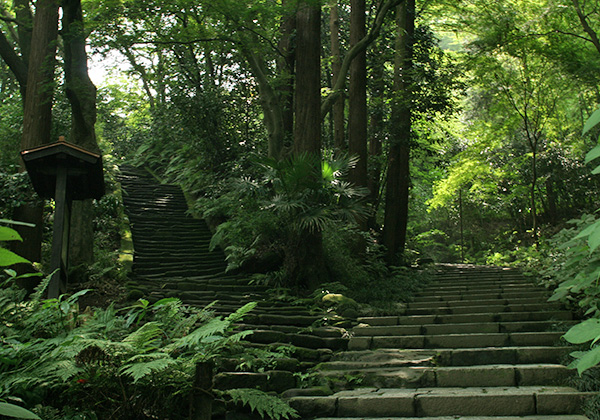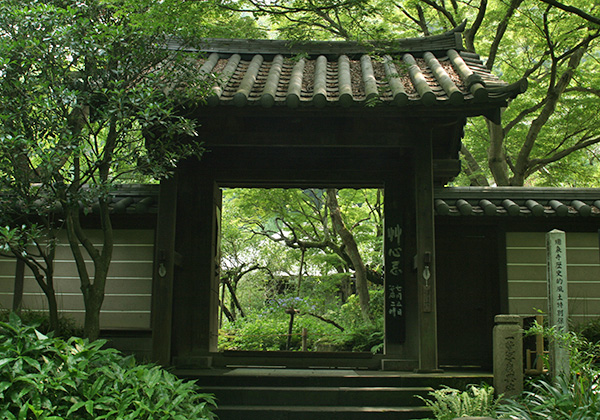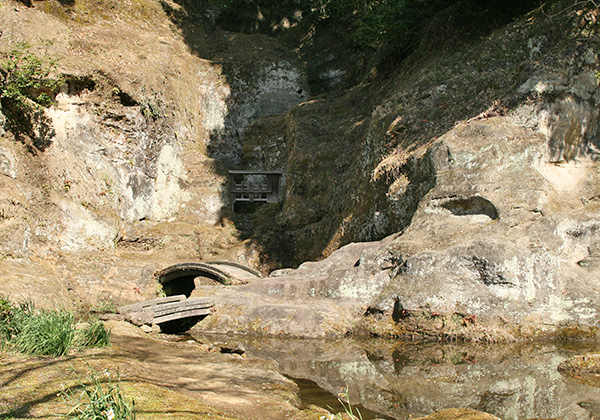Zuisenji
| Official Name | Kinpeizan Zuisenji {Pronounced kin-pay-zan zoo-e-sen-gee} |
|---|---|
| Religious sect | Engakuji School, Rinzai (Zen) Sect, Buddhism |
| Founded | in 1327 by Do-un Nikaido {doh-um nee-kye-doh} |
| Founding priest | Soseki Muso {so-seh-kee moo-soh} |
| Main object of worship | Statue of Shaka Nyorai {shah-kah nyo-rye} |
| Address | 710 Nikaido, Kamakura, Kanagawa 248-0002 (show route from current location ) |
| Location | 2,300 meters northeast of Kamakura Station |
| Time needed to get there | 35 minutes |
| Admission | JPY200 |
| Open | 9:00 - 17:00 (Last Entry Time:16:30) |
| Phone number | 0467-22-1191 |
| Restrooms | Available |
Historical Overview
The Temple was erected at the end of the Kamakura Period (1185-1333) by Do-un Nikaido (1267-1334), a high-ranking and intelligent military commander of the Kamakura Shogunate, naming Priest Muso (1275-1351) as the founding priest. Entering the Muromachi Period (1336-1573), the Temple continued to receive patronage from the Ashikaga {ah-she-kah-gah} family who controlled the Muromachi Shogunate. In fact, the Temple once had a sub-temple for the mother of Takauji {tah-kah-woo-gee} Ashikaga (1305-1358), the founder of Muromachi Shogunate. The Temple was so closely associated with the family that remains of four Kamakura Governors and other members of the Ashikaga family were buried here.
Founding priest Soseki Muso was born in Ise {e-seh}, Mie {me-eh} Prefecture. As a Zen priest, he came to Kamakura in 1295 when he was 20 years old. After studying Zen further in Kyoto, he came back to Kamakura in 1299 at the invitation of Takatoki Hojo {tah-kah-toh-kee hoh-joe} (1303-1333), the 14th Regent, and joined Kenchoji. In 1327, he was enrolled in Jochiji, while helping Nikaido to found the Temple. Engakuji nominated him as its 15th chief priest. Obai-in sub-temple in Engakuji was built solely for him, where he educated quite a few young priests, and later they were called Muso-school priests. They were so influential that it was no exaggeration to say their dogma was the mainstream of Zen Buddhism in the Muromachi Period.
In addition to Zen, Priest Muso also had an excellent talent as a garden designer. Famous gardens designed by him include those of Saihoji, a.k.a. the Moss Temple, and Tenryuji in Kyoto. Most notable among the temples he founded would probably be Rokuonji {rok-on-gee}, generally known as Kinkakuji (Gold Pavilion) in Kyoto, a favorite tourists' attraction.
One of Priest Muso's disciple was a priest by the name of Shusin Gido {shoe-shin ghee-doh} (1325-1388), who once lived in the Temple, but was mostly active in Kyoto serving Yoshimitsu {yoh-she-me-tsu} Ashikaga (1358-1408), the Third Ashikaga Shogun, as a Zen master. When Yoshimitsu and Ujimitsu {woo-gee-me-tsu} Ashikaga (1359-1398), the Second Kamakura Governor, was on the verge of crash, the Priest Gishu stepped in and settled the dispute amicably.
In its golden days, Zuisenji had more than 10 sub-temples. In the late Muromachi Period, however, the Temple's fortune began to wane with no specific patrons or sponsors. Engakuji helped the Temple in the Edo Period (1603-1868) sending chief priests from time to time. Mitsukuni Tokugawa {me-tsu-koo-nee toh-koo-gah-wah} (1628-1700), one of the most powerful and well-known members of the Tokugawa family, often came to Kamakura, and donated a wooden statue of Senju (One-Thousand Armed) Kan'non or Sahasrabhuja in Skt, which is now enshrined in the main hall.
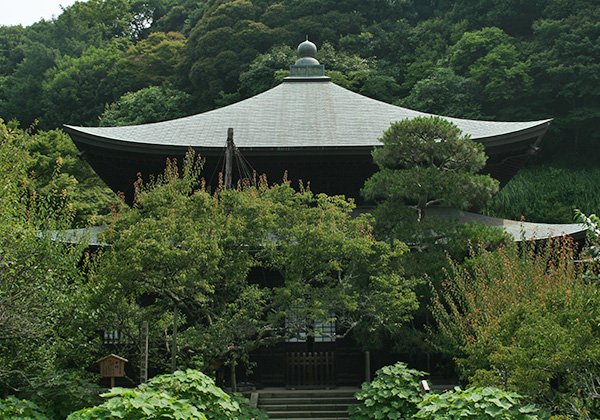
Main Hall
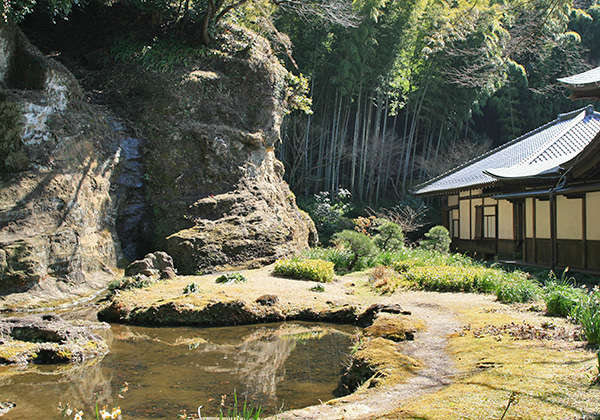
Rebuilt in 1935, it is a typical Zen style structure called Hogyo zukuri {ho-gyo zoo-koo-re} in Japanese with its roofs curved upward and rafters spread radially. On top of the roof is a peach-shaped Hoju or mani in Skt. A similar structure is also seen at the main hall of Tokeiji.
Enshrined in the center as the main object of worship is a statue of Shaka Nyorai (Sakyamuni in Sanskrit), and that of Senju Kan'non on his right. Also enshrined to the left of the Shaka statue is that of Priest Muso. All are rather small, perhaps less than 1 meter tall.
Senju Kan'non is listed as the sixth of the Kamakura Thirty-Three Kan'non Pilgrimage.
Garden
Behind the main hall lies the garden Priest Muso designed. It was restored to its original condition after the excavation in 1969 and 1970, with the help of the ancient blueprint. It has a 36-square-meter space with a pond in the center. Unlike the gardens of other Zen temples, this one uses no stones. Though visitors are not permitted to go into the garden, a bridge spanning the pond leads up to the top of a hill where a pavilion called "Henkai Ichirantei" {hen-kye e-chee-ran-tay} is located near the overhanging cliff. This was the spot Priest Muso loved to visit and many of his disciples gathered to study Buddhism. Surrounded three sides with mountains, Ichirantei command a beautiful view of Mt. Fuji to the west. On September 30, the day Priest Muso passed away, the sun is said to set right on top of the mountain.
